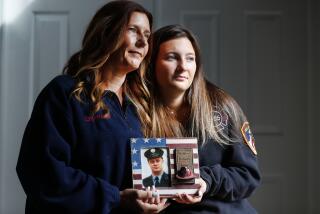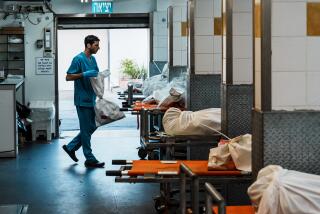A Huge, Grisly Task to Identify Bodies
- Share via
Medical examiners in Washington and New York face a grisly and potentially overwhelming task in trying to quickly identify and process the bodies of thousands of victims killed in Tuesday’s terrorist attacks.
As grief-stricken families await confirmation of the deaths, workers are pulling remains from the rubble that in many cases are far from intact. Forensic teams then must connect tattoos, teeth, implants, pieces of clothing and jewelry, somehow, to a name.
It is probably the most challenging forensic effort ever on U.S. soil, experts said.
“It’s not quite the worst nightmare, but boy, it’s close,” said Dr. Paul Hoyer, assistant medical examiner for Camden County, N.J.
Past experience with far smaller disasters suggests it will be a long, slow process.
In some cases, perhaps many, there will be no bodily remains. The bodies of passengers on the four hijacked airplanes probably were all but destroyed when the aircraft made impact at 300 mph to 400 mph and exploded. Bodies inside the Pentagon and World Trade Center may be in a similar state, depending on how close they were to the collision.
In other cases, the bodies may be so damaged or decomposed by the time they are found that it will take weeks or months to identify them through dental records or expensive DNA tests.
“There will probably be many people who are not represented in the remains that are found,” Hoyer said. “They’re just gone.”
Officials in New York face several other logistical challenges, according to medical examiners from other cities. They must find enough refrigerated space to store the remains, enough volunteers to move them and enough forensic experts to examine them.
They will also confront foul smells, body fragments and the raw emotions of grief, fatigue and anger.
“This will obviously be a very difficult learning experience for all of us,” said Mark Kowalczyk, president of the New York State Funeral Directors Assn.
Kowalczyk said the sheer number of bodies will probably require officials to set up a morgue in an airport hangar.
The last massive loss of life confronted by New York medical examiners and funeral directors was the 1996 crash of TWA Flight 800 off the coast of Long Island. Then, 230 people died, and a boat garage was used as a morgue.
In the current recovery effort, officials are hampered because they do not have a list of people who were in the World Trade Center. Some families may not know whether their loved ones were there or not.
And some people remain trapped in areas that may take days to reach.
Hoyer and other medical examiners said the multiple tasks will be divided among groups. One group will collect identifying information on potential victims: sex, age, height, weight, tattoos, implants. Another will catalog information on the remains as they are located.
Then, a computer will attempt to match the two and provide another group with leads to produce a tentative identification. Dental records or DNA tests will be needed for confirmation.
“Most people will be identified on the basis of their personal effects, which are still on them or with them,” Hoyer said.
On Wednesday morning, the New York State Department of Health put out a call for forensic teams to come to New York to help with identification, filing death certificates and preparing the bodies for funerals.
By midafternoon, they retracted the call because they had found enough.
Dr. Charles Harlan, who performs autopsies for 58 counties in middle Tennessee, volunteered to go to New York to assist with the process.
“It’s a daunting task,” Harlan said. “But you organize it and you prepare for it.”
In past cases elsewhere involving several hundred deaths, officials found themselves overwhelmed and exhausted.
After the crash of TWA Flight 800, reporters described the scene inside the makeshift morgue.
Each body was assigned a number.
Workers took pictures of each person’s number next to faces, hands with rings, tattoos, scars and other unique features. That made it easier for relatives to identify the remains.
A year earlier in Chicago, 591 deaths attributed to a massive heat wave forced the Cook County medical examiner’s office to use 10 refrigerated semitrailer trucks to store bodies.
But Cook County Medical Examiner Edmund R. Donoghue said the heat wave toll pales in comparison to Tuesday’s attacks. “There is no comparison,” he said. “They have a lot more difficult situation than we faced in the summer of 1995.”
Unlike in Chicago, “Certainly it’s possible that there are people who were involved in [these terrorist attacks] who will never be identified,” he said.
Still, he had a measure of hope. “You have to adopt a wait-and-see attitude. You can identify fragments. You’d be surprised what you can do.”
More to Read
Sign up for Essential California
The most important California stories and recommendations in your inbox every morning.
You may occasionally receive promotional content from the Los Angeles Times.










